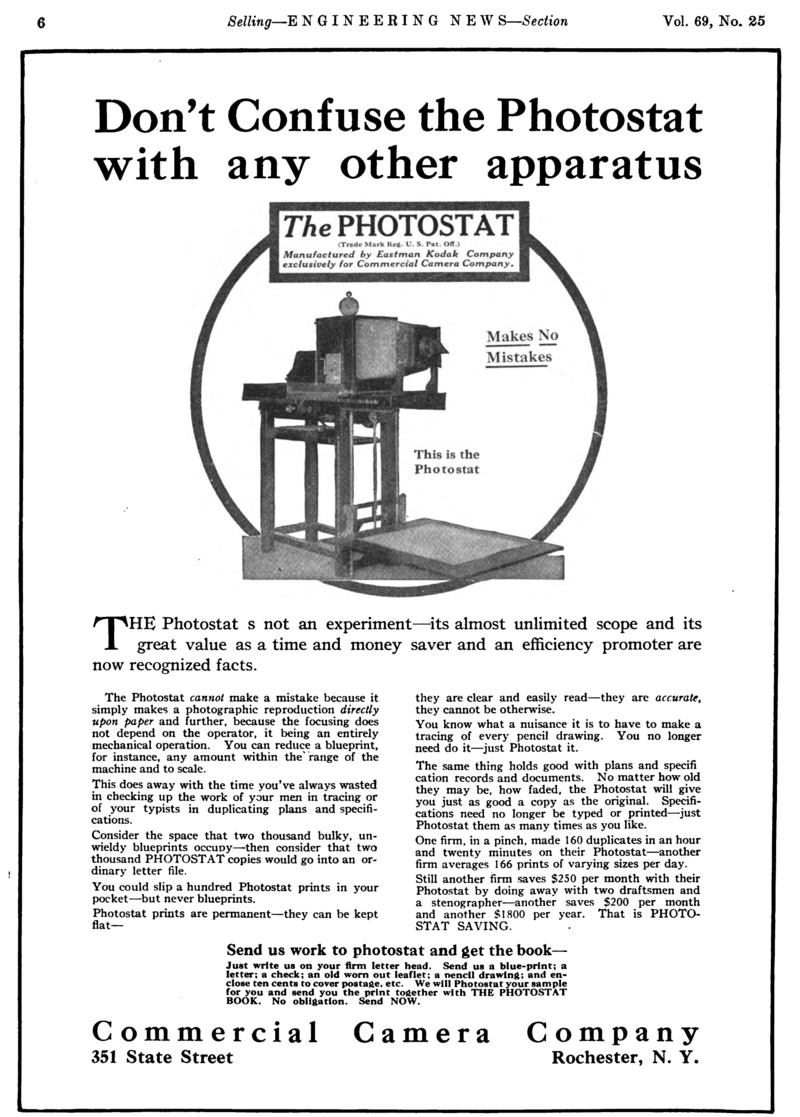The Photostat
The photostat machine was commercially released sometime after 1905, though its patent was not filed until June 1913. It entered the marketplace alongside a slew of similar technologies, such as the cameragraph and the rectigraph, which served similar purposes but had different mechanical processes.
In the United States, the term "photostat" eventually became a generic term for any sort of photographic reproduction output, process, or machine: indeed, the original patent did not have the term "photostat" at all, referring to the invention as a "Photographic Copying Device," though it was soon marketed as "The Photostat." For its first decade of existence, use of a Photostat machine was often simply referred to as "photographing" or "photo-reproduction."

A 1913 advertisement for the photostat machine, courtesy of Wikimedia Commons.
The first library to install a photostat in the United States was the Library of Congress in 1912, and the New York Public Library followed suite in December that year. The Oxford Bodleian Library installed a similar machine, with the same mechanical process, in 1907, though they used the term "rotograph," and the British Library and the Royal Library of Brussels had photostat machines by 1910. The British Library's photostat services were soon in high demand, as American scholars requested the use of their photostat machine to copy rare medieval and early modern manuscripts.
The photostat was effective at reproducing rare documents, and was useful in office and documentary settings, but while it did not require specialist labor, it was a very large and cumbersome machine and its slow process eventually became untenable for mass-document copying. Microfilm reading machines in the 1930s and early 1940s competed for the photostat's niche in manuscript reproduction, as they fulfilled a very similar need with lower processing time and smaller storage requirements. Despite this, the photostat still enjoyed use in office settings and manuscript copying, especially in the light of the threats to European libraries posed by WWII, where the destruction of libraries and their collections suddenly increased the value of photostatted manuscripts in American institutions.
It was only with the the release of the first modern-style photocopier in 1950 that the photostat's office use seriously ebbed. Afterwards, the photostat was eclipsed by the release of automatic electrophotocopiers in 1959, and the advantages of microfilming soon made microfilms the preferred method of rare manuscript copying for most of the rest of the 20th century, finally marking the end of the photostat's wider usage.
Bibliography
Aslin, E. J. “PHOTOSTAT RECORDING IN LIBRARY WORK.” Aslib Proceedings, vol. 1, no. 1, Jan. 1949, pp. 49–52. Emerald Insight, doi.org/10.1108/eb049302. Accessed 24 Jan. 2023.
Blake, Erin. “Photostats, or, The More Things Change, the More They Stay the Same.” The Collation, 23 July 2015, https://collation.folger.edu/2015/07/photostats/. Accessed 24 Jan. 2023.
Cate, Chester March. “THE PHOTOSTAT AND THE HUNTINGTON LIBRARY.” The Papers of the Bibliographical Society of America, vol. 15, no. 1, 1921, pp. 17-21. JSTOR, www.jstor.org/stable/24292486. Accessed 23 Jan. 2023.
Cole, George Watson. “THE PHOTOSTAT IN BIBLIOGRAPHICAL AND RESEARCH WORK–A SYMPOSIUM.” The Papers of the Bibliographical Society of America, vol. 15, no. 1, 1921, pp. 1-16. JSTOR, www.jstor.org/stable/24292485. Accessed 23 Jan. 2023.
Creider, Laurence S. “Accessing Medieval Religious Manuscripts on the OCLC.” Journal of Religious & Theological Information, vol. 3, no. 2, 2000, pp. 49-63. Taylor & Francis Online, doi.org/10.1300/J112v03n02_04. Accessed 24 Mar. 2023.
“Engineering News 1913-06-19: Vol 69 Iss 25.” McGraw Hill Publications Company, 1913. Internet Archive, archive.org/details/sim_enr_1913-06-19_69_25/mode/2up. Accessed 27 Jan 2023.
“Engineering News-record, Volume 69.” McGraw Hill Publications Company, 1913. Google Books, books.google.com/books?id=qj5IAQAAIAAJ&pg=RA3-PA6#v=onepage&q&f=false. Accessed 27 Jan. 2023.
Hawken, William R. Copying Methods Manual. Library Technology Program, American Library Association, 1966.
---.“Full-Size Photocopying.” Rutgers University, 1960. The State of the Library Art, vo. 5, no. 3, edited by Ralph R. Shaw. HathiTrust Digital Library, catalog.hathitrust.org/Record/001161347. Accessed 29 Jan. 2023.
Izbicki, Thomas M. “Microfilm Collections of Medieval and Renaissance Manuscripts in the United States.” Collection Management, vol. 15, no. 3-4, 1992, pp. 449-473. Taylor & Francis Online, doi.org/10.1300/J105v15n03_14. Accessed 24 Mar. 2023.
Kopp, J. J. “The Impact of Technology upon Medical History Research: The Past, the Problems, the Potential.” Bulletin of the Medical Library Association, vol. 75, no. 4, Oct. 1987, pp. 349–54. PubMed Central, www.ncbi.nlm.nih.gov/pmc/articles/PMC227757/. Accessed 23 Jan. 2023.
de Lusenet, Y. "Microfilm and Digitization As Choices in Preservation." Liber Quaterly: The Journal of the Association of European Research Libraries, vol. 13, no. 2, June 2003, pp. 112-118. doi:10.18352/lq.7723. Accessed 24 Mar. 2023.
MacKinney, Loren C. “Manuscript Photoreproductions in Classical, Medieval, and Renaissance Research.” Speculum, vol. 21, no. 2, Apr. 1946, pp. 244-252. JSTOR, www.jstor.org/stable/2851324. Accessed 24 Jan 2023.
Mcgarry, Daniel D. “The Microfilming of the Vatican Manuscript Library.” American Documentation, vol. 9, no. 1, Jan. 1958, pp. 50–58. EBSCOhost, doi-org.proxy2.library.illinois.edu/10.1002/asi.5090090108. Accessed 26 Mar. 2023.
Metcalf, Keyes D. "Implications of Microfilm and Microprint for Libraries." Library Journal, vol. 121, no. 15, 1996, pp. 2. ProQuest, www.proquest.com/trade-journals/implications-microfilm-microprint-libraries/docview/196727810/se-2. Accessed Feb 19 2023.
“Microfilms and Photostats of European Manuscripts.” Speculum, vol. 29, no. 2, 1954, pp. 336–38. JSTOR, www.jstor.org/stable/2849371. Accessed 24 Mar. 2023.
Myers, James. “A Study of Photostating: University Photoduplication Service.” University of Michigan at Ann Arbor, 1967. HathiTrust Digital Library, catalog.hathitrust.org/Record/000646762/Home. Accessed 29 Jan. 2023.
Orr, Robert W.. "Photostats in a College Library." College & Research Libraries, vol. 7, no. 3, 1946, pp. 220-223. doi.org/10.5860/crl_07_03_2207.3. Accessed 24 Mar. 2023
“The Photostat And Its Operation.” Rochester, N.Y. Photostat Corp., 1936. HathiTrust Digital Library, catalog.hathitrust.org/Record/000783445. Accessed 24 Jan. 2023.
Powers, Eugene B. “The Manuscript Copying Program in England.” The American Archivist, vol. 7, no. 1, Jan. 1944, pp. 28-32. JSTOR, www.jstor.org/stable/40288368. Accessed Feb. 3 2023.
Raney, M. Llewellyn. Microphotography for Libraries. American Library Association, 1936.
Seidell, Atherton. “Documentation and Microfilm Copying.” American Documentation, vol. 7, July 1956, pp. 231–32. EBSCOhost, proxy2.library.illinois.edu/login?url=https://search.ebscohost.com/login.aspx?direct=true&db=lls&AN=521680400&site=ehost-live. Accessed 24 Mar. 2023.
United States Patent and Trademark Office. “US-1127231-A.” 2 Feb. 1915. https://image-ppubs.uspto.gov/dirsearch-public/print/downloadPdf/1127231. Accessed 27 Jan. 2023.